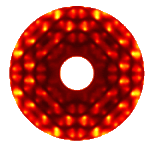Interactive example: Phase angles IV

Phase problem
Shift in real space
Centrosymmetric vs. Acentric
Interactive examples
Single atom
Pair of atoms
One atom in unit cell
Two atoms in unit cell
Goto
Contents
The controls on the right allow you to create two
electrons, Si or Pb atoms located within a unit cell.
The unit cell represents a cubic crystal of 10 Angstroem lattice
constants.
The position of the atoms/electrons is given in fractional coordinates.
Four diagrams will be plotted. The first displays the position of the
atoms, the second (the lower left diagram) displays the position of
the Bragg reflection in reciprocal space. The third diagram (upper right)
shows the real and imaginary part of the Bragg reflection in the
complex plane. The x-axis
reflects the real part, the y-axis the imaginary part of the
structure factor. The angle between the positive x-axis and the
structure factor represents the phase angle. The three different
colors represent the contributions of atom 1 and atom 2 and the
total structure factor. The final diagram displays
the corresponding numerical values.
Start exploring and try to answer the questions below:
- Work out the relationship between the individual contributions and the total structure factor.
- What is the effect, if you choose two different atoms?
- For an H0 reflection, can you place two identical atoms such that the amplitude of the structure factor is zero?
- Which coordinates are relevant for this placement x and/or y ?
- Use a general HK reflection. Again try to place two atoms such that the total structure factor amplitude is zero.
- Find relative placements of the two atoms such that all H0 reflections with H odd have zero amplitude.
- Find relative placements of the two atoms such that all HK reflections with (H+K) odd have zero amplitude.